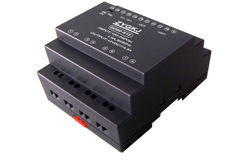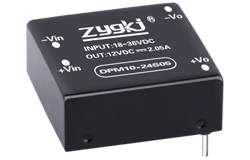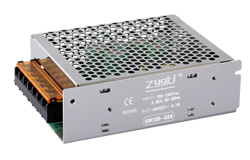noticias
Designing an AC-DC Converter Circuit
Autor: Módulo de potencia ZYG Time: 2023-5-2
Introduction
AC-DC converters are electronic circuits used to convert an AC voltage to a DC voltage. These circuits are used in a wide range of devices, including power supplies for electronic equipment, battery chargers, and LED drivers. In this article, we will discuss the design of an AC-DC converter circuit.
Design Considerations
The design of an AC-DC converter circuit involves several considerations, including the input voltage, output voltage, output current, and efficiency. The input voltage is the AC voltage that is to be converted to DC. The output voltage is the DC voltage required for the load. The output current is the current that the load requires. The efficiency is the ratio of the output power to the input power.
The design of the AC-DC converter circuit involves selecting the appropriate components, including the diode bridge, smoothing capacitor, and voltage regulator. The diode bridge is used to convert the AC voltage to a pulsating DC voltage. The smoothing capacitor is used to remove the ripples in the DC voltage. The voltage regulator is used to regulate the DC voltage to the required level.
Circuit Diagram
The circuit diagram of the AC-DC converter is shown below.
The circuit consists of a diode bridge, a smoothing capacitor, and a voltage regulator. The diode bridge is made up of four diodes, D1 to D4. The AC voltage is applied across the diode bridge, and the pulsating DC voltage is obtained at the output of the diode bridge.
The smoothing capacitor, C1, is connected in parallel with the output of the diode bridge. The capacitor charges to the peak voltage of the pulsating DC voltage and discharges when the voltage drops. This results in a smoother DC voltage at the output of the capacitor.
The voltage regulator, IC1, is connected to the output of the smoothing capacitor. The voltage regulator regulates the DC voltage to the required level. The output of the voltage regulator is connected to the load.

Component Selection
The selection of the components for the AC-DC converter circuit depends on the input voltage, output voltage, output current, and efficiency requirements. The diodes should be capable of handling the peak voltage of the AC input. The smoothing capacitor should have a suitable capacitance value to provide adequate smoothing of the DC voltage. The voltage regulator should be chosen based on the required output voltage and output current.
Efficiency
The efficiency of the AC-DC converter circuit is an important consideration. The efficiency is the ratio of the output power to the input power. The efficiency can be calculated using the following formula:
Efficiency = (Output power / Input power) x 100%
The efficiency of the circuit depends on the losses in the diode bridge, smoothing capacitor, and voltage regulator. The diode bridge has a voltage drop of about 0.7V per diode, resulting in a total voltage drop of 1.4V. The smoothing capacitor has a leakage current that causes a small loss. The voltage regulator has a dropout voltage that causes a loss. The efficiency of the circuit can be improved by selecting components with low losses.
Conclusion
In conclusion, the design of an AC-DC converter circuit involves selecting the appropriate components, including the diode bridge, smoothing capacitor, and voltage regulator. The design considerations include the input voltage, output voltage, output current, and efficiency. The circuit diagram shows the arrangement of the components. The component selection depends on the requirements of the circuit. The efficiency of the circuit can be improved by selecting components with low losses.
Anterior: Industrial AC-DC Converter: Efficient and Reliable Power Conversion
Próximo: Understanding AC-DC Power Supply: A Comprehensive Guide
informacion relevante
-
2023-11-27
Fully Modular Power Supply: The Ultimate Solution for Efficient and Customizable Energy Management
In today's technology-driven world, energy management has become a critical concern for individuals and businesses alike. The demand for electricity is increasing at an unprecedented rate, making it essential to find innovative solutions to optimize energy consumption. One such solution is the fully modular power supply, which offers efficient and customizable energy management capabilities. A fully modular power supply is a type of power supply unit (PSU) that allows the user to connect only the necessary cables and detach the unused ones. Unlike traditional PSUs, which come with a fixed set of cables, fully modular PSUs provide flexibility and versatility in managing power distribution. One of the key advantages of a fully modular power supply is its efficiency. By eliminating...
Ver detalles -
2023-6-24
Bidirectional DC DC Converter: Principles, Topologies, and Applications
A bidirectional DC-DC converter is a power electronic device that can transfer electrical energy bidirectionally between two DC voltage levels. It is widely used in various applications, including electric vehicles, renewable energy systems, and battery energy storage systems. This article will explore the principles, topologies, and applications of bidirectional DC-DC converters. Principles of Bidirectional DC-DC Converter The main function of a bidirectional DC-DC converter is to transfer power from one DC voltage level to another. The power transfer can be either unidirectional or bidirectional. A bidirectional converter can transfer energy from a high voltage source to a low voltage load and vice versa. Bidirectional DC-DC converters typically consist of two power converters, each with its own power switch and control...
Ver detalles -
2023-4-13
Convertidor AC-DC: conversión de corriente alterna a corriente continua
AC-DC converters are electronic devices that convert alternating current (AC) to direct current (DC). This conversion is necessary for many electronic devices that require DC voltage to operate, such as computers, cell phones, and televisions. The process of converting AC to DC involves several steps. First, the AC voltage is typically stepped down using a transformer to a lower voltage level, which is then rectified to produce a pulsating DC voltage. The pulsating DC is then filtered using capacitors to produce a more stable DC voltage. The resulting DC voltage can then be regulated using voltage regulators to ensure that it is within the required voltage range for the electronic device. There are several types of AC-DC converters,...
Ver detalles -
2023-8-9
Introducing the SF Series: AC DC Power Supply for Reliable and Efficient Power Delivery
In today's technologically advanced world, a reliable and efficient power supply is crucial for the smooth operation of various devices and systems. Whether it is powering industrial machinery, medical equipment, or computer systems, a stable and high-quality power source is essential. This is where the SF Series AC DC Power Supply comes into play. The SF Series AC DC Power Supply is a cutting-edge solution that has been designed to meet the diverse needs of different industries. With its advanced features and superior performance, this power supply ensures reliable and efficient power delivery, ensuring uninterrupted operations even in the most demanding environments. One of the key features of the SF Series AC DC Power Supply is its versatility. It offers...
Ver detalles -
2023-4-18
Building a 120V AC to 3V DC Power Supply
Introduction: A power supply is an essential component in any electrical or electronic system. It provides the necessary power for the system to operate. In this article, we will discuss how to build a 120V AC to 3V DC power supply. The power supply can be used for a variety of applications such as powering low voltage circuits, charging batteries, and powering small electronic devices. Design: The power supply is designed to convert the 120V AC voltage from the mains into a 3V DC voltage. The power supply consists of a transformer, a bridge rectifier, and a voltage regulator. Transformer: The transformer is used to step down the 120V AC voltage to a lower voltage suitable for the power supply....
Ver detalles -
2023-12-1
650W Fully Modular Power Supply: The Ultimate Power Solution for Efficiency and Convenience
Where technology is an integral part of our lives, having a reliable and efficient power supply is essential. Whether you are a gamer, a content creator, or simply a tech enthusiast, the 650W fully modular power supply is the ultimate power solution for efficiency and convenience. This article will delve into the features and benefits of this power supply and why it is the perfect choice for your needs. Efficiency: One of the key features of the 650W fully modular power supply is its high efficiency. With an efficiency rating of over 90%, this power supply ensures that minimal energy is wasted during the conversion process from AC to DC. This not only reduces your electricity bills but also helps...
Ver detalles


















